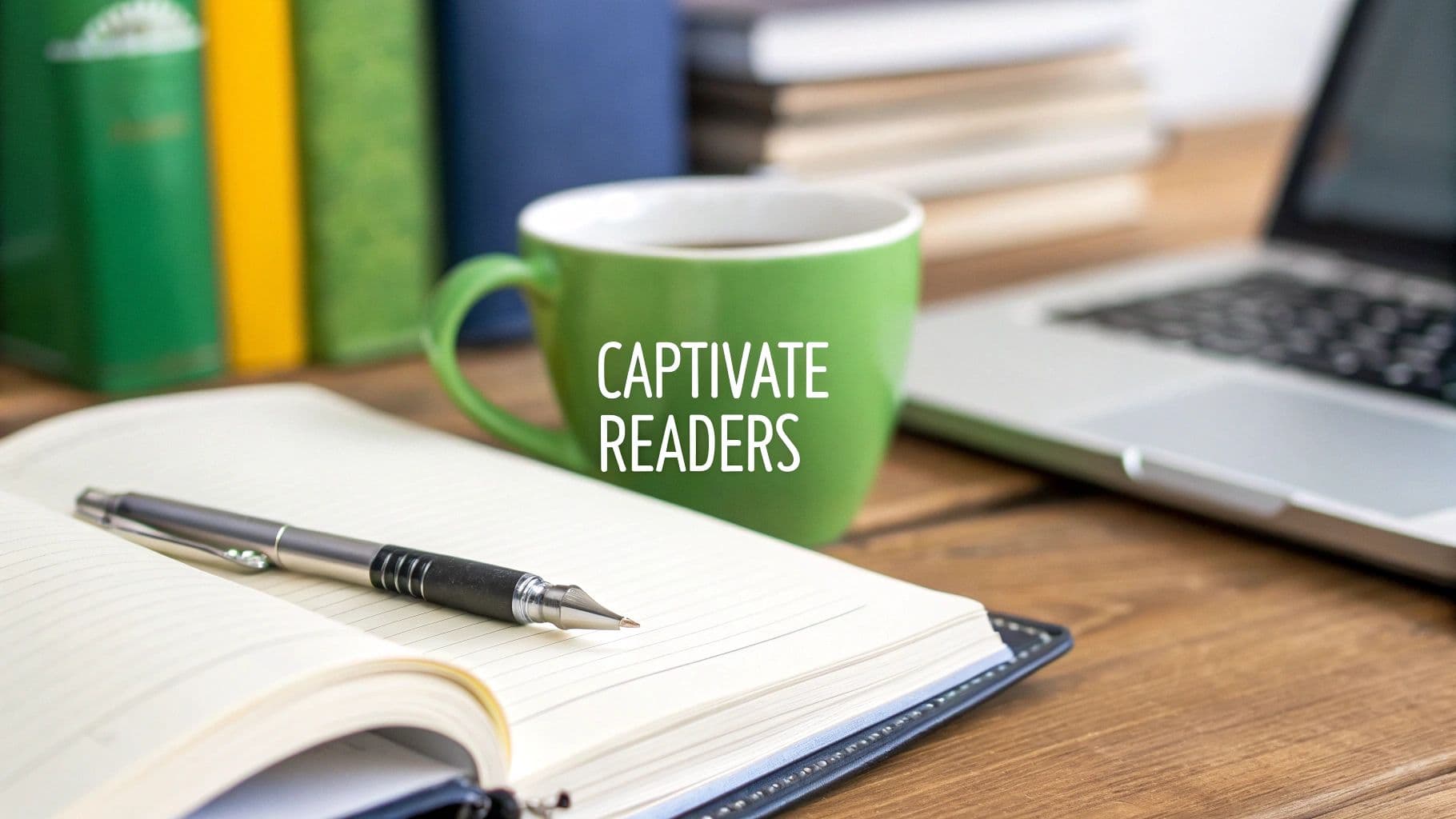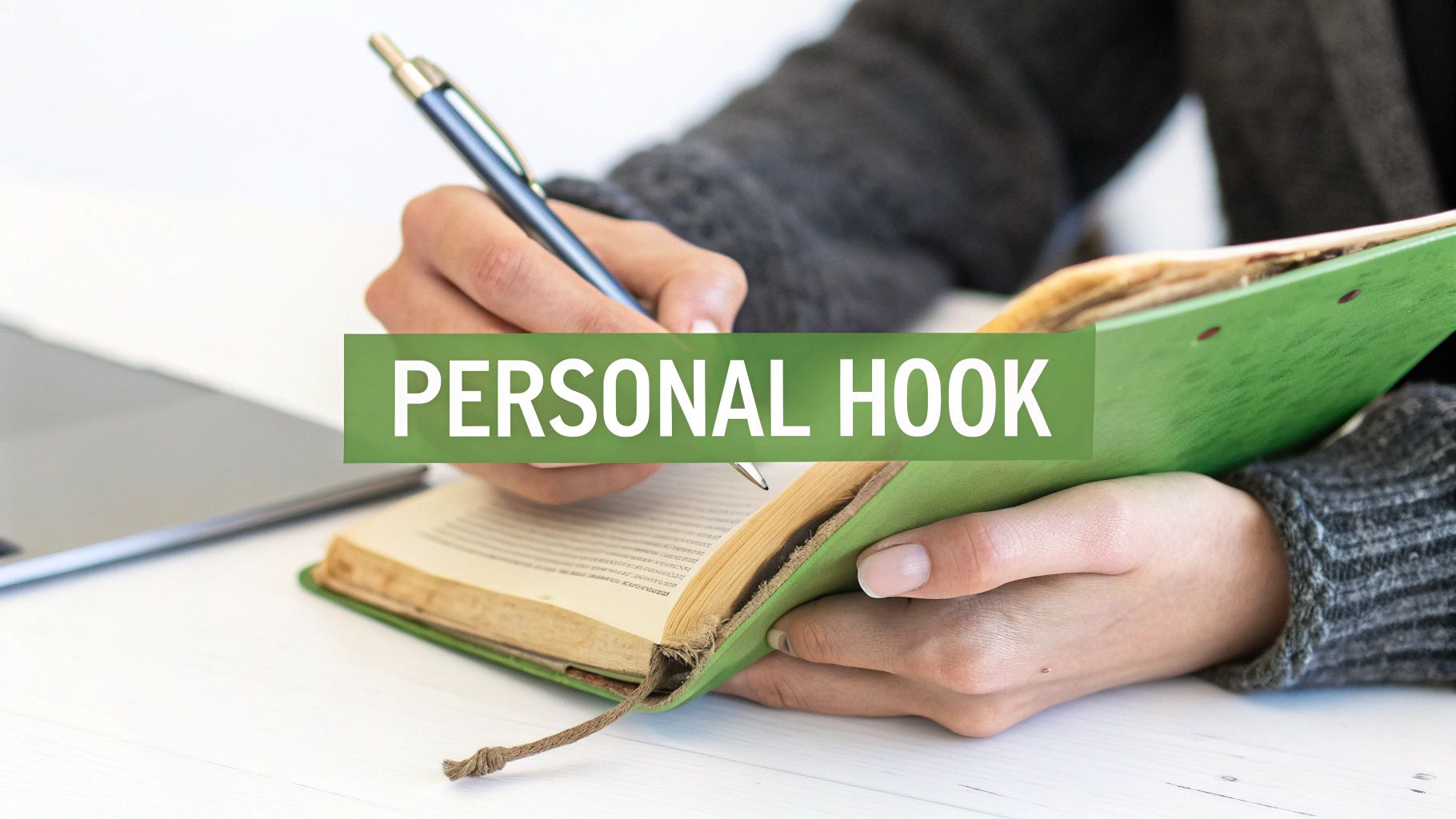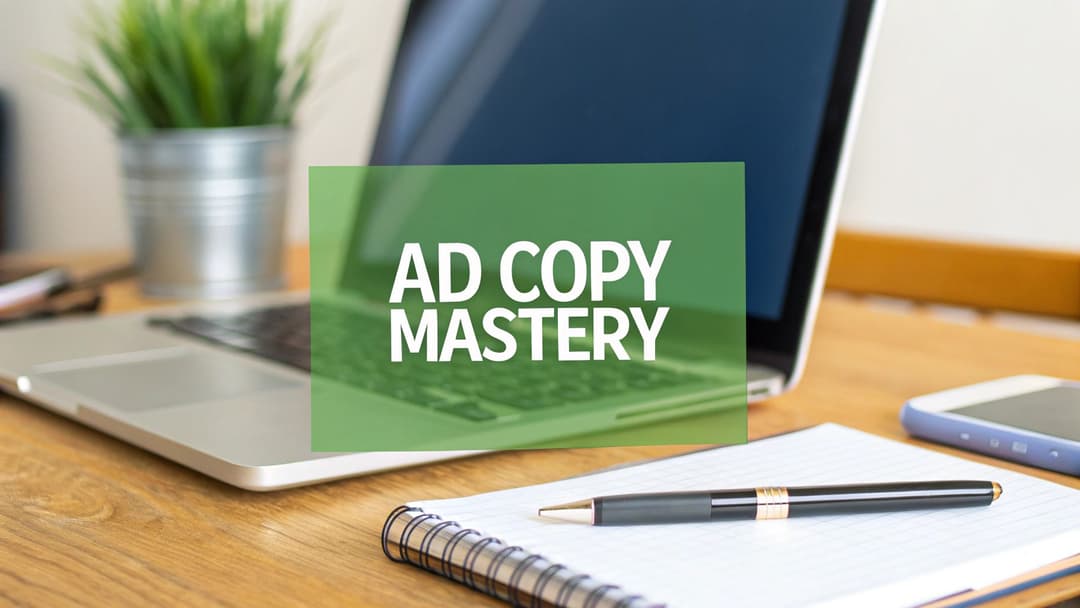
How to Write a Hook for an Essay That Captivates
November 13, 2025
So you want to write a killer essay hook? The first step is to grab your reader with an opening sentence they can't ignore. This isn't the time to be subtle. Think surprising statistics, a question that makes them lean in, a powerful quote, or even a short, punchy story. The goal is simple: make them so curious they have to read the next sentence.
The Undeniable Power of a Strong Essay Hook
Your essay’s first sentence is your one and only chance to make a first impression. It’s the gatekeeper to your entire argument. If it’s boring, you’ve lost the reader before you’ve even shared your thesis. A great hook does more than just fill a line—it sets the entire tone for your piece.
Think of it as a promise you make to the reader. A shocking statistic promises a well-researched, credible argument. A personal story promises a relatable, human connection. This initial promise builds instant anticipation and signals that you know what you're talking about. An essay that starts with "Throughout history, many things have happened" has already lost the battle.
Why Your Opening Line Matters Most
The psychology here is pretty straightforward: people are busy. Whether it's a professor with a stack of papers to grade or an admissions officer skimming applications, their attention is a limited resource. A strong hook respects their time by getting straight to the point and showing them your essay is worth the read.
It handles a few critical jobs right away:
- Creates Immediate Engagement: It pulls the reader out of a passive state and gets them actively thinking about your topic from the very first word.
- Establishes Credibility: A well-crafted hook shows you're a thoughtful writer who knows how to build a compelling case.
- Sets the Tone and Voice: It instantly tells the reader if your essay is going to be analytical, personal, persuasive, or even a little humorous.
A great hook isn't just a clever trick; it's a fundamental part of effective communication. It signals to your reader that you value their time and have something important to say.
Connecting with Your Reader Instantly
Ultimately, a hook is all about connection. It finds common ground or introduces a new perspective that makes the reader pause and think. It's the difference between an essay that feels like a chore and one that feels like an interesting conversation.
This principle isn't just for academic papers, either. To get a better feel for the mechanics of drawing people in, it helps to explore different effective introduction styles to hook readers from other types of writing. Mastering this skill is how you make sure your ideas get the attention they truly deserve.
Using Statistics and Facts to Build Credibility
There's something about a hard number that just grabs your attention. A surprising statistic or a startling fact can instantly pull a reader in, making them sit up and pay attention. Why? Because using data right from the get-go shows your essay is built on a foundation of research and reality, establishing your credibility before you've even made your first point.
When you lead with a fact, you're doing more than just sharing information. You're signaling to your reader that you’ve done the work and that your argument is going to be worth their time.
This decision tree gives you a quick visual on when to pull out the data. If your goal is to inform or persuade, a fact-based hook is one of the most powerful tools in your arsenal.

As the infographic shows, when you need to be persuasive or informative, a solid statistic is often your best bet.
Finding the Right Numbers
Of course, not all stats are created equal. The trick is to dig up data that is both surprising and directly relevant to your main argument. A generic statistic just won't land with the same punch as one that challenges a common belief or reveals the true scale of an issue.
For instance, instead of a vague statement like, "Lots of people use social media," try hitting them with this: "The average person now spends over two hours and 27 minutes on social media every single day—adding up to nearly two full months out of every year." The specificity is what makes it so memorable and powerful.
You can unearth credible data from reliable sources like:
- Academic journals and peer-reviewed studies
- Government reports (think Census Bureau or CDC data)
- Respected think tanks and nonprofit organizations
Framing Facts for Maximum Impact
Once you've got your killer stat, how you present it is everything. Don't just drop a number and walk away. You need to frame it in a way that sparks curiosity. This is especially true for expository writing, where your main job is to explain a topic clearly. If you want to dive deeper into this style, you can learn more by exploring what is expository writing and see how a strong, factual opening sets the stage perfectly.
Here's a little research-backed insight for you: 68% of high-scoring essays on standardized tests like the SAT and ACT open with a statistic or fact. And get this—essays that lead with a statistic are 42% more likely to earn top marks than those starting with a broad, general statement. You can read more about the findings on effective essay hooks to see the data for yourself.
The best statistical hooks do more than just state a fact—they imply a story. They make the reader wonder, "Why is that number so high?" or "What does that mean for me?"
This approach turns a cold, dry number into the start of a compelling narrative. If you were writing an argumentative essay on mental health, a hook like, "One in five adults in the United States lives with a mental illness," immediately makes your topic feel urgent and widespread. It grounds your argument in the real world and makes it impossible for the reader to just scroll past.
Choosing the Right Hook for Your Essay Type
The hook you choose should feel like a natural entry point for the type of essay you're writing. A shocking statistic works wonders for a persuasive paper, while a thoughtful question might be better suited for a reflective piece. Getting this alignment right is key.
Here's a quick guide to help you match the right hook with the right essay.
| Essay Type | Most Effective Hook Type | Why It Works |
|---|---|---|
| Argumentative | Surprising Statistic or Fact | Immediately establishes credibility and the importance of your topic. |
| Expository | Clear Definition or Bold Claim | Sets a clear, informative tone and tells the reader exactly what to expect. |
| Narrative | Anecdote or Vivid Description | Pulls the reader directly into a personal story or scene, creating an emotional connection. |
| Compare & Contrast | Intriguing Question | Prompts the reader to consider the relationship between two subjects from the start. |
| Persuasive | Shocking Statement or Quote | Grabs attention and creates an emotional or intellectual stake in your argument. |
Think of this table as a starting point. The goal is to choose an opening that not only grabs attention but also smoothly transitions into your thesis and the broader purpose of your essay.
Bring Your Topic to Life with a Historical Hook
Dropping your reader into a specific moment in history is a killer way to add instant weight to your essay. A historical hook does more than just state a fact; it frames your argument within a bigger, more meaningful story, making your writing feel sophisticated right from the first sentence.
Why does this work so well? It grounds your topic in a shared human experience. Instead of floating an abstract idea, you’re tethering it to a real event that people can picture. Suddenly, your argument feels less like a classroom exercise and more like something that genuinely matters.
Connect the Past to the Present
The trick is to pick a historical moment that actually syncs up with your essay's theme. A random, forced reference will just feel awkward. But get it right, and you create a fascinating "then and now" dynamic that grabs your reader's curiosity.
For example, if you're writing about the ethics of AI, you could kick things off by talking about the Industrial Revolution's impact on human labor. It's a parallel that immediately shows you’re thinking deeply about the long-term consequences of your topic.
Here are a few ways this could play out:
- For a Literature Essay: Writing about The Hunger Games? Start with a quick reference to the gladiatorial games of Ancient Rome to get your reader thinking about violence as entertainment.
- For a Political Science Paper: An essay on modern political divides could open with a description of the tension-filled years leading up to the American Civil War.
- For a Science Essay: You could introduce a paper on vaccine development by recounting the desperate, frantic search for a polio vaccine in the 1950s.
This isn't just a stylistic flourish; it gets results in high-stakes academic writing. A report by the College Ready Plan, which looked at 5,000 college application essays, found that 34% of the most memorable essays started with a historical reference. Even better, those essays were 27% more likely to be flagged by admissions officers as truly standout pieces. You can dig into more of these findings in their analysis of memorable essay hooks.
How to Write an Opening That Lasts
When you're crafting a historical hook, think vivid but brief. You’re not writing a textbook chapter; you're just setting a scene. A few well-chosen details are all you need to transport the reader to that time and place.
A great historical hook makes your essay feel both timeless and incredibly relevant. It tells the reader your argument isn't just about today—it's part of a much larger story.
Don't just state a date; describe the moment. Instead of saying, “In 1929, the stock market crashed,” try something with more punch: “On a crisp October morning in 1929, the roar of the trading floor fell silent, replaced by a wave of panic that would soon drown the global economy.” See the difference? That's how you turn a simple fact into a compelling entry point—a perfect move when you're figuring out how to write a hook for an essay that people will remember long after they're done reading.
Crafting Personal Hooks That Connect

Sometimes the most powerful stories aren't buried in history books or hidden in data sets. They're in your own life.
Using a short, personal story as a hook creates an instant connection. It makes your reader feel like they’re listening to a friend, not just reading an assignment. This is your chance to show the human side of your argument before you even get to the main point.
This approach works wonders for narrative, descriptive, and especially college application essays. It transforms your writing from a formal piece into something deeply relatable. The trick is finding a brief, relevant story that introduces your core theme without giving everything away.
Finding the Right Story
The perfect anecdote is a tiny snapshot of a much larger experience. It needs to be quick, but packed with enough emotion and detail to pull the reader right in.
Think about a moment that genuinely shaped your perspective on the topic you’re writing about.
For an essay on resilience, you could start with something like this: “The first time I tried to ride a bike without training wheels, I ended up with a scraped knee and a bruised ego. But as I stared at the fallen bike, my grandfather’s words echoed in my head: ‘The fall is part of the ride.’”
This simple story immediately builds a personal connection and introduces the theme of resilience in a way that sticks. If you want to dive deeper into weaving personal experiences into your writing, it's worth exploring different narrative writing techniques.
A personal hook isn’t just a story; it's a bridge between your experience and the reader's empathy. It tells them, "I've lived this," making your argument feel more authentic and earned.
Keeping Your Anecdote Sharp and Relevant
The biggest challenge with a personal hook is knowing when to stop. Your anecdote should be a teaser, not the whole movie. The goal is to set the scene and introduce a core emotion or idea, then smoothly transition into your thesis statement.
Here are a few tips to keep your personal hook on point:
- Focus on a single moment. Don't try to tell your entire life story. Zero in on one specific, impactful event.
- Use sensory details. Instead of just saying you were nervous, describe your "shaking hands" or the "lump in your throat." Show, don’t tell.
- Keep it brief. Your hook should only be a few sentences. A good rule of thumb is to keep it under 50 words.
Let’s look at a quick comparison to see what this looks like in practice.
| Vague Anecdote | Specific, Engaging Anecdote |
|---|---|
| I learned about teamwork from playing sports. | "With ten seconds left, the ball flew toward me. In that split second, I had a choice: take the risky shot myself or pass to my teammate who had a clearer view of the net. That moment taught me more about trust than any textbook ever could." |
| A trip I took changed my view on life. | "Standing on a crowded street in Tokyo, unable to read a single sign, I felt a wave of panic. But when a stranger noticed my confusion and offered a smile and a map, I learned that kindness needs no translation." |
Notice how the specific examples use action and emotion? They create an immediate sense of being there. That's the secret to a personal hook that truly resonates and makes someone eager to read what you have to say next.
Advanced Hooks That Command Attention

Alright, you’ve got the basics down. But if you really want to make your essay unforgettable, it’s time to move beyond standard hooks. We’re talking about the kind of opening that takes a calculated risk to grab your reader and not let go.
Think of it this way: a standard hook is a polite handshake. An advanced hook is the one that looks the reader in the eye and makes them lean in, curious. It’s a bold move that signals you have something genuinely interesting to say.
Start With a Deliberate Misconception
One of the most powerful ways to hook a reader is to tell them something they already believe is true… and then pull the rug out from under them. This technique taps into a common assumption and then immediately flips it on its head.
It creates a jolt of surprise. Suddenly, the reader needs to know how you’re going to dismantle their worldview.
For an essay on sustainable fashion, you could open with: "For decades, the fashion industry has sold us a simple story: buy more, be happier." That line feels familiar, right? But then you pivot to your thesis, exposing the destructive reality behind that myth. The initial moment of agreement makes your counterargument land with so much more force.
Ask a Question They Can't Ignore
A good question makes your reader think. A great one makes them feel like the answer is just out of reach, compelling them to read on to find it. This is more than just a lazy, "Have you ever wondered...?" It's a sharp, specific query that gets right to the core of your topic.
See the difference?
- Weak Question: "Is technology good or bad for society?"
- Strong Question: "What if the tools designed to connect us are actually building taller walls between us?"
The second question is worlds better. It’s specific, uses a powerful metaphor, and frames the entire debate in a fresh, intriguing way. It sets the stage for a much more nuanced argument.
The goal of an advanced hook isn’t just to be clever. It’s to create an intellectual or emotional investment in your topic from the very first sentence.
A detailed meta-analysis that reviewed over 20,000 essays actually found that combining hook types—like a bold statement followed by a question—made essays 38% more likely to be rated as highly engaging. What's more, in persuasive essays, readers preferred statistical hooks 72% of the time. It just goes to show that mixing data with a creative frame is a winning combo. You can explore more of these findings about what makes a great hook.
Find a Quotation That Surprises
Using a quote can feel like a classic, safe move. To elevate it, you need to find one that’s unexpected and directly challenges the reader. Ditch the overused quotes from Einstein or MLK that everyone has seen a million times.
Instead, dig for a line from a lesser-known expert, a surprising historical figure, or even a piece of modern pop culture that perfectly nails your argument.
The key here is context. Don't just drop the quote and run. Introduce it, and then immediately explain why it’s so relevant or disruptive. This shows you’re not just borrowing someone else’s credibility; you’re using their words as a launchpad for your own original ideas.
Your Top Questions About Essay Hooks, Answered
Even when you know the different types of hooks, a few practical questions always seem to pop up. Let's tackle the most common ones I hear from students. Getting these details right can be the difference between a good hook and a great one.
When Should I Write the Hook—First or Last?
This is the classic chicken-or-the-egg question of essay writing. It feels natural to start at the beginning, but honestly, most experienced writers I know save the hook for last.
Think about it: once your entire essay is done, you have a crystal-clear sense of your argument, your evidence, and the exact tone you’ve struck. It’s so much easier to craft a powerful, relevant opening when you know precisely what you're introducing.
How Long Should an Essay Hook Be?
Keep it short and punchy. Your hook should be one to three sentences, max.
The goal is to grab attention fast, not to lay out your entire argument. A hook that drags on is a fast way to lose your reader's interest before they even get to your thesis.
A hook's job is to create curiosity, not to explain your entire argument. Keep it short, sharp, and focused on making the reader ask, "What comes next?"
What If My Hook Just Feels Weak or Forced?
If your hook feels awkward, don't muscle through it. A forced hook can be even worse than a boring one because it comes off as inauthentic. This usually happens when the connection between your clever opening and your actual thesis is a stretch.
Stuck with a weak hook? Try one of these quick fixes:
- Read it out loud. Does it sound clunky or unnatural? Your ears will pick up on awkward phrasing your eyes might miss.
- Switch it up. If your statistic is falling flat, try turning it into a provocative question. If your anecdote isn't landing, find a surprising fact instead.
- Get a second opinion. Ask a friend to read only your first paragraph. If they aren’t curious to read more, you know it’s time to head back to the drawing board.
Don’t let the hunt for a perfect hook paralyze you. Sometimes, it’s best to just write a simple, direct opening sentence and come back to polish it later.
Can a Hook Be Too Controversial?
There’s a fine line here. A bold or slightly controversial statement can be incredibly effective because it immediately challenges your reader's perspective. It makes them sit up and pay attention.
But you have to be careful. The goal is to provoke thought, not to be needlessly shocking or offensive. A claim that’s way out in left field or just plain false will tank your credibility from the get-go.
Make sure you can actually back up any bold statement you make in the body of your essay. A wild, unsupported claim doesn’t just weaken your argument; it can also wander into academic integrity issues. You can learn more about this in our guide on how to avoid plagiarism. At the end of the day, your hook is there to serve your argument, not to overshadow it.
After crafting the perfect hook, ensure the rest of your essay is just as compelling. Natural Write can help you transform your drafts into polished, human-like text that reads smoothly and passes AI detection with ease. Try it for free at https://naturalwrite.com.


